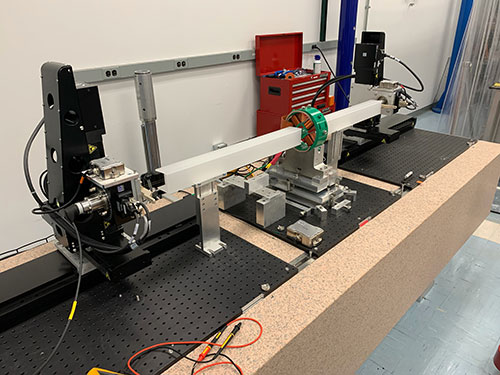
Accelerator
Accelerator Research
As one of the most advanced synchrotron light sources in the world, National Synchrotron Light Source II enables researchers to tackle the most important challenges in quantum materials, energy storage and conversion, condensed matter and materials physics, chemistry, life sciences, and more by offering extremely bright light, ranging from infrared to x-rays.
It’s not just the visiting researchers that perform world-class science and engineering at the facility. The NSLS-II Accelerator Division divides their attention between maintaining the ideal experimental conditions for users and developing new insights into accelerator physics, engineering, and potential next-generation light sources.
Building Strong Collaborations
The different groups within the division use their expertise to build strong collaborations with other accelerator-based research facilities around the globe. Through these collaborations, NSLS-II’s accelerator team contributes to building the next generation light source, which will enable new capabilities and research opportunities for many other areas of science.
The division is currently assisting in the project development of upgrading critical components for two other U.S. light sources. The following overview lays out four of the most notable projects, which have been selected from over 20 different projects.
Magnet Development
The accelerator division is designing, prototyping, and procuring 165 special 8-pole corrector magnets for the upgrade of the Advanced Photon Source (APS-U) at Argonne National Laboratory. These magnets will help in creating a highly stable beam orbit, which APS-U needs to achieve its designed brightness full potential.
Diagnostics and Controls
The team is also involved in the development of critical diagnostics and controls for the APS upgrade. They are working on machine protection systems that will keep essential components of the accelerator safe, designing a horizontal collimators system that will help shape the electron beam during beam dump, and developing a beam emergency shut-off monitor to ensure safe operations.
Power Supplies
For the Advance Light Source Upgrade (ALS-U) project at Lawrence Berkeley National Laboratory, NSLS-II experts are developing power supplies that will run ALS-U magnets found in three sections of their accelerator complex. These magnets are essential to shape and guide the electron beam through the different sections of the accelerator complex. The team will deliver more than 1,000 of these highly stable power supplies to the ALS-U project.
Prototyping Vacuum Elements
Both update projects, ALU-U and APS-U, asked for the expertise of NSLS-II staff in coating vacuum chambers and devices for their new accelerators. For the APS-U project, the accelerator division designed, fabricated, and tested devices called stripline kickers, which are essential for injecting the electron beam into the accelerator. For the ALS-U, the team coated ceramic chambers that will be part of kicker magnets in the ALS-U accelerator complex.
Creating the Future of NSLS-II
In addition to operating NSLS-II accelerators and contributing to the build-out of NSLS-II beamlines, the division plays a key role in planning the long-term future of the NSLS-II facility. One key role includes focusing on the sources of the synchrotron light: accelerators, insertion devices, and front-ends, which shape the initial light beam. The first step on this path is to reach mature performance of the machine, while maintaining its reliability, and optimize the conditions for running experiments. For this step, the plan is to complete the spare inventory for accelerator systems, build necessary redundancy and resilience for least reliable systems, and construct new systems needed for better electron beam performance.
However, the division also looks beyond routine operations of the machine. They carry out Research & Development programs to initiate and develop new trends in the evolution of brighter and more capable sources of synchrotron light. In collaboration with other institutions, they work on accelerator designs for future light sources at Brookhaven and in other US labs.
Research Project Overviews
The following sections offers a brief overview of the diverse, ongoing research projects within the accelerator division. They are organized by the different systems and areas they affect within a particle accelerator.
Lattice and Single-particle Dynamics
AC LOCO Technique for Lattice Correction
The accelerator division developed a new, advanced technique to improve the precision of the linear optics from closed orbits (LOCO) lattice characterization. This technique, called AC LOCO, is based on sine-wave beam excitation via fast correctors. The beam oscillations are measured by all beam position monitors. The narrow-band signals used for the beam excitation and measurement allow us to improve the signal-to-noise ratio and provides the opportunity for simultaneous excitation of multiple correctors at different frequencies [PRAB 20 (2017) 054001].
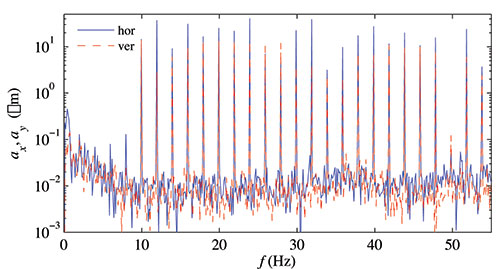
Effect of Undulators on Magnet Lattice and Emittance
The team developed and tested a lattice model of the NSLS-II ring with three damping wigglers and 17 undulators. The lattice distortion introduced by each insertion device (ID) is locally compensated using six quadrupole magnets located nearby. A minimum horizontal emittance of 0.76 nm was measured with all the IDs. The measured values of the emittance, radiation energy loss, and energy spread show a good agreement with analytical formulae and numerical simulations [PRAB 22 (2019) 124001].
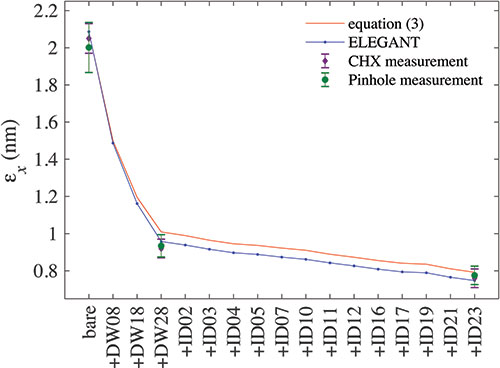
Square Matrix Method
Researchers developed a novel square matrix method to optimize the nonlinear beam dynamics. The main feature of the new method is that a high mathematical order can be achieved in one step. This is a significant advantage when compared with the canonical perturbation theory and normal form, where the calculation is carried out order-to-order by a complicated iteration. The developed theory shows good potential in the theoretical understanding of a complex dynamic system to guide the optimization of dynamic apertures in circular accelerators [PRAB 20 (2017) 034001].
Genetic Algorithm with Machine Learning
The team enhanced a multi-objective genetic algorithm by including machine learning techniques and applied it to optimize the NSLS-II dynamic aperture. The researchers verified the quality of some optimal candidates obtained with this technique experimentally and by particle tracking simulation. This technique can be applied to other population-based optimization problems such as particle swarm algorithms [PRAB 21 (2018) 054601].
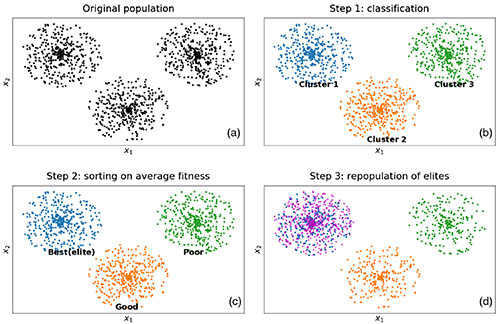
ID Coupling Correction
Some users, especially those of coherent beamlines and imaging beamlines, will benefit from 8 pm-rad diffraction limit vertical emittance. Some insertion devices show coupling-gap dependence, thus affecting vertical beam emittance and beam size stability. The team implemented two ways to compensate coupling and improve machine operation beam size and emittance stability: a global coupling feedforward system and a local coupling feedforward system. [IPAC2018 WEPAF017]
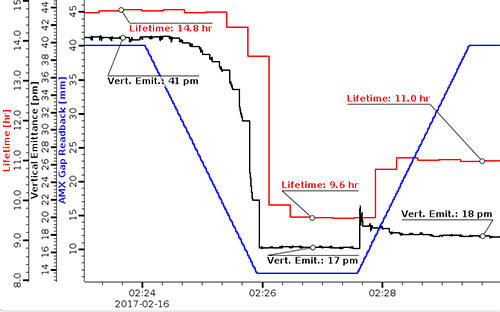
Multi-particle Dynamics, Collective Effects, and Impedances
Novel Features of Longitudinal Beam Dynamics
The accelerator division observed and studied novel features of the single-bunch longitudinal instability in a low-emittance electron storage ring at NSLS-II. The team found a non-monotonic increase of the beam energy spread with the bunch current. They explained that each local minimum is a higher-order microwave instability threshold. They published their results in a high-impact journal called Scientific Reports [SciRep 8 (2018) 11918].
Beam Dynamics with a Higher-Harmonic Cavity
The team studied longitudinal beam dynamics, both analytically and numerically, in a storage ring with a higher-harmonic cavity (HHC). The team reviewed general conditions for the HHC operations, during active and passive modes. For NSLS-II, the team specifically analyzed the stability and performance of the system in the presence of an ion-cleaning gap in the bunch fill pattern using the self-consistent solver of the Vlasov-Fokker-Planck equation [IJMP A 34/36 (2019) 1942040].
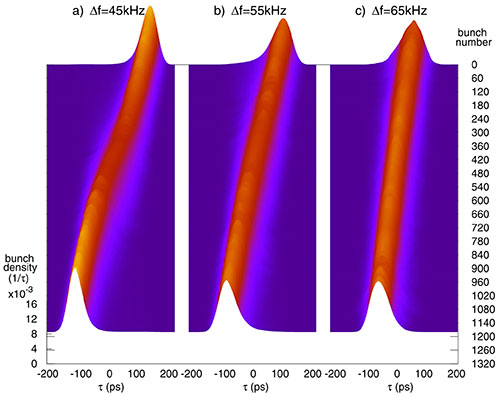
Advanced Technique of Local Impedance Measurement
Researchers developed and tested an advanced technique of local impedance measurement. The basis of this technique was created by measuring the impedance (or electrical resistance) from the sine-wave excitation of an orbit bump inside of the vacuum chamber section. The narrow-band signals used for the beam excitation and measurement allow the scientists to improve the signal-to-noise ratio and to eliminate the systematic errors caused by magnet hysteresis and orbit drifts [NIM A 871 (2017) 59–62].
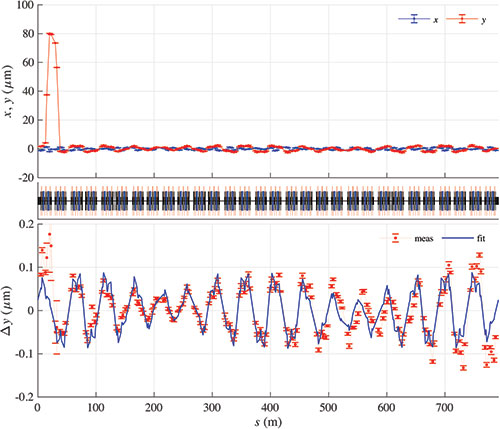
Beam-induced Heating of Stripline Electrodes
Scientists studied the beam-induced heating of stripline electrodes experimentally, analytically, and numerically. Their temperature analysis is based on the power loss calculation using the loss factor computed by the 3D electromagnetic simulation code GdfidL. The team used the ANSYS finite-element code to correlate the temperature with the power loss. Then, they compared the analytical equations with the numerical simulations and determined a frequency range of the formulae applicability [NIM A 963 (2020) 163729].
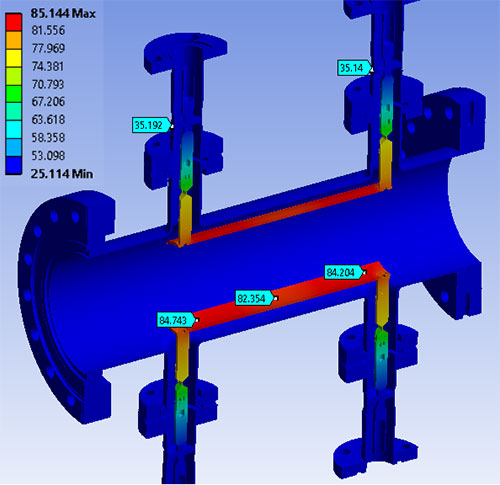
Ultrafast Electron Diffraction and Microscopy
The accelerator division studied ultrafast electron diffraction (UED) and ultrafast electron microscopy (UEM), two powerful research tools complementary to the light sources, in the framework of two Brookhaven National Laboratory directed Research and Development projects. A new transverse focusing system based on electromagnetic quadrupole lenses resulted in a significant improvement of the diffraction image [SciRep 9 (2019) 5115].
The team developed a new beam diagnostic method based on the analysis of the electron diffraction image and successfully applied it to measure shot-to-shot energy fluctuation and spatial-pointing jitter [SciRep 9 (2019) 17223].
The researchers also proposed a novel monochromator providing extremely low beam energy spread. This proposal could pave the way to building a UEM with a sub-nanometer spatial resolution and a UED with a ten-femtosecond temporal resolution [SciRep 10 (2020) 16171].
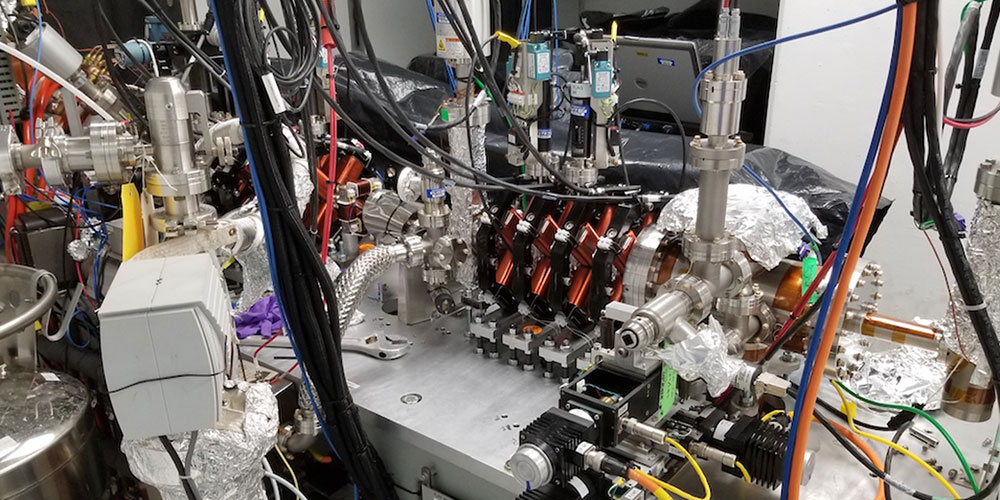
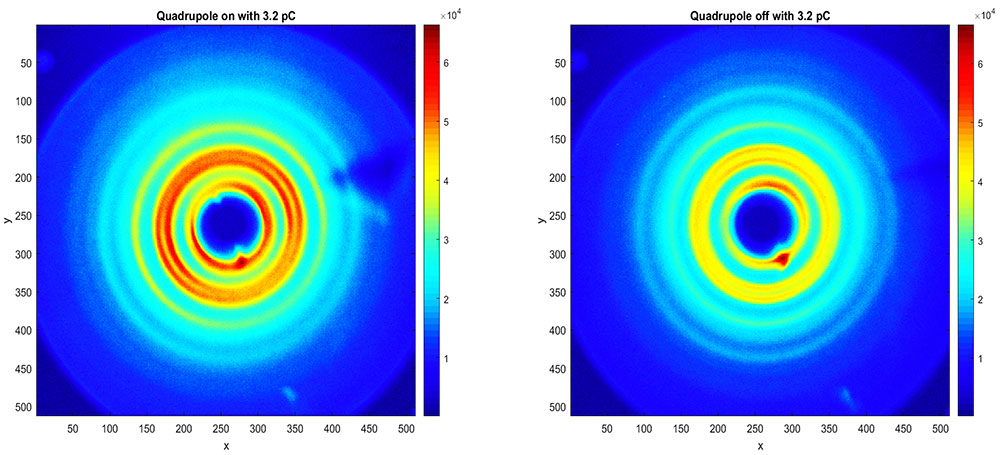
Engineering Projects
Accelerator Tunnel Surveillance Robot
Experts from the electrical engineering group developed a robot to perform surveillance and measurements inside the NSLS-II accelerator tunnel during beam operations. The new robot is equipped with two visible cameras, an infrared camera, a radiation monitor, and a temperature monitor and, therefore, can diagnose issues with overheating of components and water leaks as well as perform radiation surveys and visual inspections of accelerator components. The robot provides a view of the inside of the tunnel for the control room operators when accelerators are in operations and are inaccessible for visual inspection.
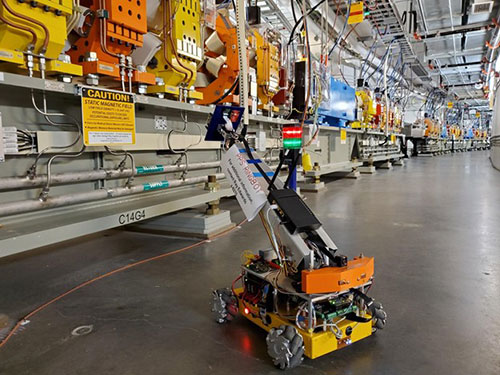
Electronics for Radio-Frequency Beam Position Monitor
Engineers from the diagnostics and instrumentation group designed and built new, beyond state-of-the-art radiofrequency beam position monitors (RFBPM), incorporating the latest technology available in the radiofrequency, digital, and software domains. The team uses these RFBPMs to monitor the electron beam orbit within the NSLS-II synchrotron with a sub-um precision. Due to the in-house development of these essential detectors, the accelerator division can adapt and improve the system, increasing reliability of operations and beam stability for every beamline community at NSLS-II.

Third harmonic bunch lengthening cavity
The radiofrequency/cryo group designed an innovative two-cell 3rd harmonic superconducting cavity to lengthen the bunches within the storage ring, thereby increasing the beam lifetime in NSLS-II. The new cavity can provide the necessary 1.5 Mega-Volts at 1.5 Gigahertz so that it allows the team to use a single cryostat per straight section, instead of using a third straight section in the ring. The use of superconducting cavities is far more efficient for bunch lengthening due to their inherent low losses, low higher order modes, which would otherwise spoil the beam, and passive beam-induced voltage. Therefore, this eliminates the need for additional radiofrequency transmitters.
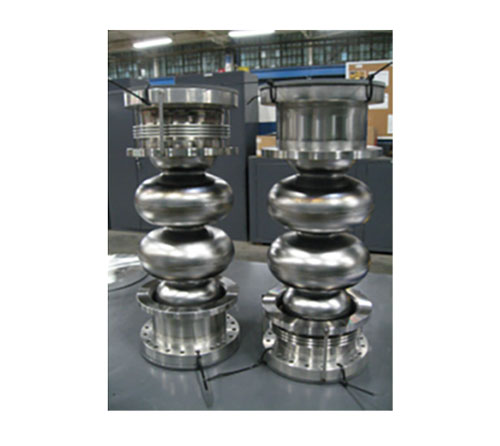
Ultrafast Electron Microscope
Supported by Brookhaven’s Laboratory Directed Research and Development (LDRD), team from the accelerator division is developing an ultrafast electron microscope for imaging of cells with sub-nanometer resolution. The aim of the ongoing project is to assess the design of an ultra-high resolution microscope that will become an enabling instrument for various life science research to complement x-ray studies on biological samples. The team designed and constructed the proof of principle setup for such a device to demonstrate its imaging capabilities.
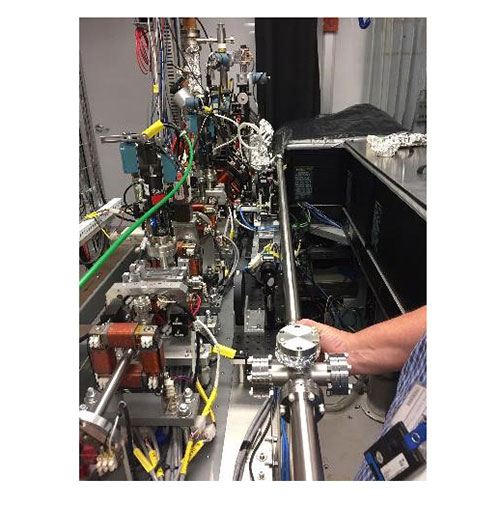
APS-U Stripline
The accelerator division is fabricating high-voltage stripline kickers for the APS-U project at Argonne National Laboratory. This project includes refining the mechanical design and fabricating a total of nine kicker units: four injection/extraction kickers, two decoherence kickers, and three feedback kickers. The team will test some of the kickers in the NSLS-II storage ring to improve the final design. The team has already made significant improvements in the alignment and control electrode deflection, as well as on the high emissivity coating for the electrodes and interior chamber walls to reduce electrode heating by the powerful beam passing inside. APS-U will receive all kickers, including documentation and control units, as finished products.
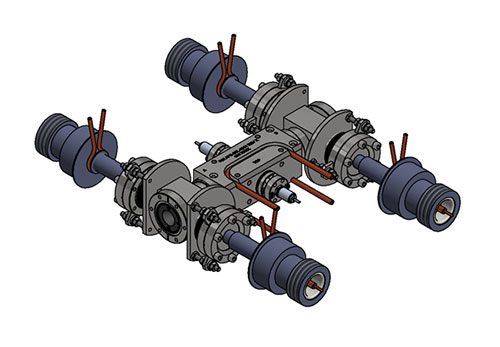
New Magnetic Measurement System
The insertion device and mechanical engineering groups have set up a new magnetic measurement system for the precise study of magnets used in particle accelerators. Using this new measurement bench, the team can determine the most important parameters of a magnetic field such as its field harmonics, fiducialization, gradient, and center with high precision. The new measuring bench will help guarantee that the fields of future magnets fulfill the demanding specifications for current and future accelerators.
